
Paul Gauguin, Nafea Faa Ipoipo (When Will You Marry?) (1892)
Photo: courtesy of Wikipedia.
Paul Gauguin’s 1892 painting, Nafea Faa Ipoipo (When Will You Marry?), is coming to the Phillips Collection in Washington, DC.
The most expensive painting ever sold was reportedly purchased by the Qatar Museums for nearly $300 million back in February, smashing the old record for Paul Cézanne’s late 19th century work, The Card Players, which sold for an estimated $250 million.
The seller was Rudolf Staechelin, a retired Sotheby’s executive who lives in Basel.
Nafea Faa Ipoipo (When Will You Marry?) comes to the Phillips as part of “Gauguin to Picasso: Masterworks from Switzerland, The Staechelin and Im Obersteg Collections,” drawn from the collection of Karl Im Obersteg (1883–1969) and Staechelin’s father, also named Rudolf (1881–1946). Both men were from Basel and avid collectors of Impressionist, Post-Impressionist, and School of Paris artists.
Vincent van Gogh, The Garden of Daubigny (1890).
Photo: courtesy the Rudolf Staechelin
Collection.
Also among the over 60 paintings in the show are Vincent van Gogh’s The Garden of Daubigny (1890); Pablo Picasso’s Woman at the Theater/The Absinthe Drinker (1901), a double-sided work; and a suite of three massive 1914 portraits of rabbis by Marc Chagall.
The exhibition is actually the reason that the 1892 oil painting was sold; the Gauguin canvas had been on loan to the Kunstmuseum in Basel for close to 50 years, but the institution would not let the artwork travel while it was closed for renovations. This violated the terms of the loan, which stipulated that the painting remain on public view.
Staechelin seized the opportunity to monetize part of his father’s collection. “I always tried to keep as much together as I could, [but] over 90 percent of our assets are paintings hanging for free in the museum. It’s not a healthy financial risk distribution,” he explained to the New York Times. “For me they are family history and art. But they are also security and investments.”
Marc Chagall, Jew in Green (1914).
Photo: courtesy Im Obersteg Foundation/Artists Rights Society.
The Kunstmuseum’s loss is, for now at least, the Phillips Collection’s gain. The show is traveling to Washington, DC, from the Museo Nacional Centro de Arte Reina Sofía, Madrid, for its only stop in the US. It previously appeared at Basel’s Beyeler Foundation.
“I am thrilled by the opportunity to bring such important and spectacular works to Washington—pieces that don’t normally travel,” said Dorothy Kosinski, the museum’s director and exhibition co-curator, in a statement. “The exhibition shows the perspicacity of these two very important 20th-century patrons and supporters of modernism.”
Related Stories:
What Are The Top 10 Al-Thani Family Art Acquisitions?
Keanu Reeves to Give Talk on Gauguin—Say What?
Scientific Tests on Paul Gauguin’s Teeth Indicate the Artist Did Not Have Syphilis